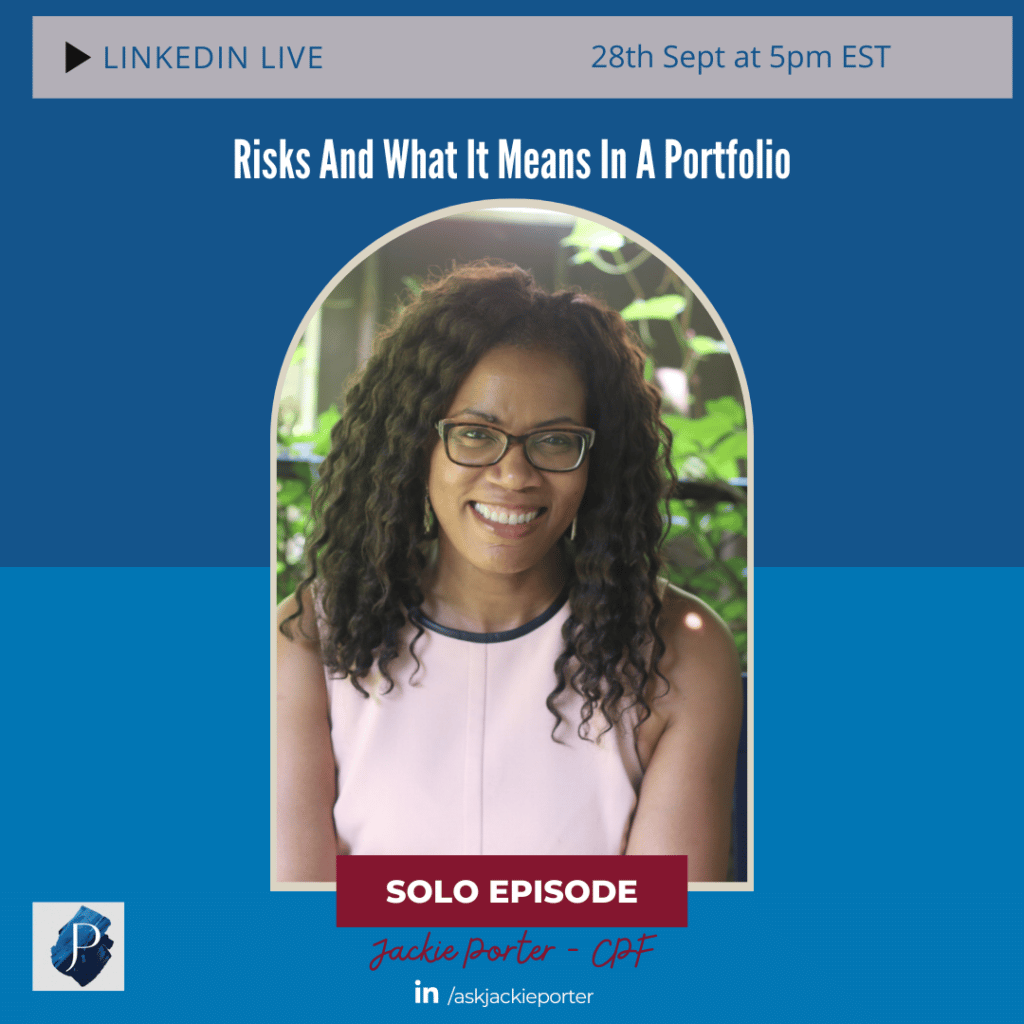Hello confidante community! Thanks for checking out the Live@5 summary as we wrap up the investments theme for September. The latest episode is a solo one with Jackie on What Risk Means for your Investment Portfolio. Jackie shared helpful tips on how to handle the volatility in the market right now. Please feel free to share your experience with the current market with us in the comments under this article. Worried about your investment portfolio? This is the piece you need to read!
What are market risks?
Market risk is the risk of seeing your investments go down because of certain market factors. There are 5 types of market factors that impact your investments. The first one is equity risk, this is a type of risk that affects stocks, mutual funds or ETFs. The second factor is interest rate risk, this type of risk is associated with the cost of borrowing money. Keep in mind, a rise in interest rates can reduce the value of your investments. This risk affects all categories of investments, market whether it is investing in stocks or the value of your home. Keep in mind the higher the interest rate to buy a home the less consumers can afford to buy a home which affects home prices as well.
The third risk is the currency risk, this risk is associated with the exchange rate of the currency you are buying investments in against other foreign currencies. This simply means if the Canadian dollar gets stronger, you’ll be able to buy more US shares (for example) of an investment with same dollar amount as before. The risk on the negative side is the CAD could be worth less which will affect the value of your USD investments being worth less as well after factoring the currency exchange rate.
The fourth investment risk is the commodity risk, a good example of this oil prices rising in costs and how it affects the prices of other investments that rely on oil to produce their good or service. The final risk is inflation risk or the risk of essential costs of goods and services going up and its impact on the price of investments. Recognizing all of these risks, you need to ask yourself whether or not your investment returns are earning enough to keep up with the rising cost of living? Keep in mind that although the stock market goes up and down it has been a reliable asset class for keeping up with inflation.
Are there really any risk free investments?
The most important tip is to speak to an advisor to help you determine how much risk you can afford to take in the short term and how much loss you can live with now, for the long-term growth you are seeking in the future. The reality of investing is there’s really no investment that does not have risks. Low stable returns like GIC’s mean there is still the pain of having to keep up with rising costs in the future. So, with risk free investments, you have to worry about running out of money in the long run as a result of a higher cost of living as time goes by. Also consider the after-tax cost of investments held outside of RSP’s and TFSA’s as the taxes payable on these investments affect return and the money left in your pocket at the end of the day. Find a trusted financial planner that can help you iron the details of your investment plan so you can achieve your long-term goals.
Lets talk about liquidity risks
Tying back to the fact that there are no risk free investments and everyone should make decisions based on their goals and time frame you have to think of situations when you need money for an emergency. This scenario is where the liquidity risk comes in, are you easily able to get cash when you have a pressing need based on the type of investments you are holding? Remember cash is still king, ensure your short term investments are cashable when you need them instead of non redeemable.
What’s the best way to reduce risks?
Match your time horizon with your risk tolerance and make sure you are investing long term so you don’t panic when short term losses starts to spring up. Be sure to match your time horizon with your risk tolerance level and make sure you are buying investments based on your comfort level with loss. Another important tip is diversification, you need to hold investments in different asset classes, such as bonds and stocks, and in different investment categories such as real estate investments, technology and bank stocks. Having your investments in different baskets gives you some level of protection and helps to avoid steep short term losses on your portfolio. Another strategy is to make monthly contributions to your investments as opposed to buying at one price in the market. The last tip is really knowing what kind of investor you are, are you an aggressive one or a more conservative one? A financial advisor will better help you understand what type of investor you are and how your portfolio can match your financial plan in the long run. Remember, the biggest risk you can face is not sticking to your plan and making emotional decisions as you go.
So do you have an advisor? Do you have one that you’re comfortable with and can trust with your entire portfolio? If you don’t, feel free to book out free strategy session to potentially kick start your financially secure future. Send an email to jody.euloth@askjackie.ca as we are always happy to help





More Financial News & Events
Exploring Financial and Emotional Resilience
Mindshift Mastery and Emotional Resilience
Creating a mentor mindset: How to become one or find one
Jan
Legal Financial Fitness: A Comprehensive Checklist for Thriving Practices
Jan
How to Mentally and Financially Prepare for a Layoff
Jan
2023 tax considerations you may have missed
Dec
How to Hold on to More of Your Cash this Holiday Season
Dec
Financial Moves to Make Before Year End
Dec
Navigating Stagflation: Financial Resilience in Uncertain Times
Nov
Buying and selling real estate amidst inflation
Nov
Navigating the Changing Tides: Real Estate, Inflation, and Rising Mortgage Rates
Nov
How does inflation affect your financial plan?
Nov
Caring for aging parents: The journey and lessons learned along the way
Oct
Resources For managing care for Aging Parents
Oct
Talking to Aging Parents About Finances
Oct
Living your best life: Infusing your best life into your your everyday
Oct
Living your best life: Striking the balance between enjoying life now or enjoying it later
Sep
Living Your Best Life: Client Testimonials and Insights
Sep
Unpacking FOMO: Understanding biases, emotions and financial attitudes
Aug
How to overcome FOMO to not overspend this summer
Aug
How to Overcome FOMO on Investments
Aug
What behaviours undermine your ability to build wealth
Jul
How Do You Loose Wealth
Jul
What Does Wealth Building Mean to Our Clients?
Jul
Estate Planning: What You Can Learn From the Mistakes of Celebrities
Jun
Estate Planning For Lawyers
Jun
Estate Planning for Business Owners
Jun
Managing growth for business owners
May
Are you a lawyer with questions on how to grow your investments?
May
Cultivating a growth mindset around money
May
Why financial growth can be deceptive
May
Home and Financial Document Organization
Apr
Business owners, it’s time to start spring cleaning.
Apr
Spring Cleaning Your Finances
Apr
Unique financial challenges female lawyers face
Mar
Taking Action: A Woman’s Perspective on Deciding To Tackle Her Finances
Mar
Is there a gap in your income protection?
Mar
Knowing the difference between Tax Filer and Tax Advisor
Mar
Conquering Women’s Fears Around Finances
Mar
Trends in Family Law
Feb
PART 2: Financial Conversations Couples Need To Have at Different Life Stages
Feb
Financial Conversations Couples Need To Have at Different Life Stages
Feb
Disruption and Reinvention: Starting a Second Career in your Forties
Jan
How to create a strong financial fortress during market downturns
Jan
Creating a Financial Vision Board for 2023
Jan
5 Tips to set yourself up For Financial Success in 2023
Jan
Year-end Donation strategies
Dec
Year-end tax planning
Dec
Getting clients organized for 2023
Combating Quiet Spending
Nov